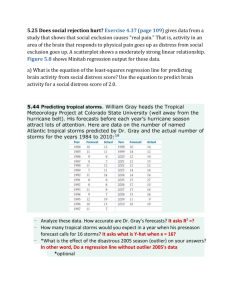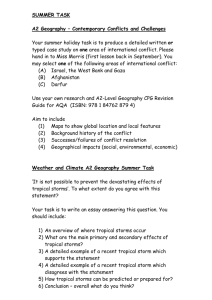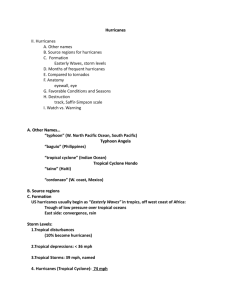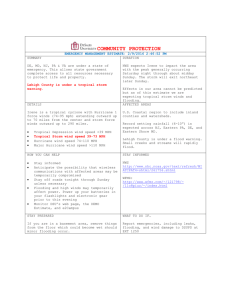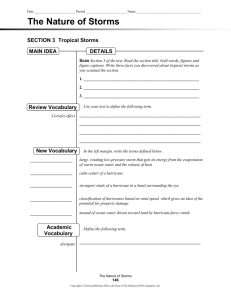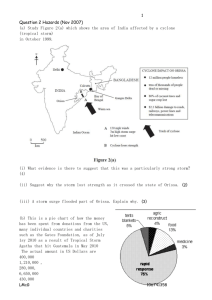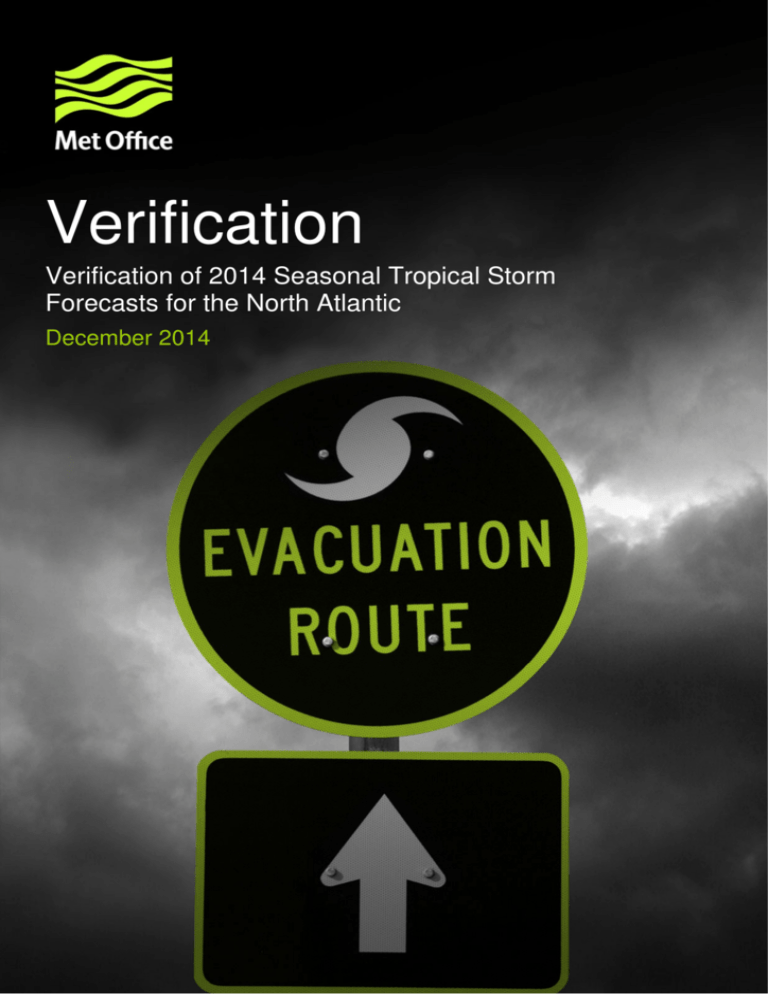
Verification
Verification of 2014 Seasonal Tropical Storm
Forecasts for the North Atlantic
December 2014
© Crown copyright 2014
1
Verification of 2014 Seasonal Tropical Storm Forecasts for
the North Atlantic
Issued December 2014
1. Executive summary.............................................................................................. 3
2. The 2014 Atlantic hurricane season ................................................................... 3
3. Forecast verification ............................................................................................ 4
5. Future forecasts ................................................................................................... 5
6. References ............................................................................................................ 6
Appendix ................................................................................................................... 7
This report was prepared in good faith.
Neither the Met Office, not its employees,
contractors or subcontractors, make any warranty,
express or implied, or assume any legal liability or
responsibility for its accuracy, completeness, or any
party’s use of its contents. The views and opinions contained
in the report do not necessarily state or reflect those of the Met Office.
© Crown Copyright 2014
© Crown copyright 2014
2
2
1. Executive summary
The 2014 hurricane season recorded only 8 tropical storms (winds ≥ 39 mph), making it one
of the quietest seasons in the past twenty years. Out of 8 storms, 6 became hurricanes
(winds ≥ 74 mph) and 2 of these reached major hurricane strength (winds ≥ 111 mph). The
accumulated cyclone energy (ACE) index—a measure of the combined strength and
duration of tropical storms during the season—was 65.11. This represents around 63% of
the 1980‒2010 average ACE index of 104 and is the 4th lowest ACE index since 1995, the
start of the current era of high activity in the North Atlantic. The low number of tropical
storms in 2014 was due in part to strong vertical wind shear and mid-level subsidence over
the tropical Atlantic and Caribbean Sea (CSU 2014), which created unfavourable conditions
for tropical storm development and intensification.
One hurricane (Arthur) made landfall in the United States; for the ninth year in a row the
United States experienced no major hurricane landfalls. The Caribbean was hit by three
storms (Bertha, Gonzalo and Hanna); Mexico and Central America were impacted by two
Atlantic tropical storms as well as several Pacific tropical storms.
Monthly updated forecasts issued by the Met Office over the period April to September 2014
provided good guidance on the number of tropical storms and hurricanes, with observed
values falling within the predicted range for all forecasts issued. Forecasts of ACE index
also performed well with observed values falling within the predicted range for all forecasts
issued apart from August. Forecasts of major hurricane numbers are currently not issued.
2. The 2014 Atlantic hurricane season
A summary table of tropical storm activity during 2014 and a corresponding plot of storm
tracks are provided in Table 1 and Figure 1 of the Appendix, respectively. Based on
historical records since 1944 the 2014 hurricane season was joint 14th lowest for named
storms (8), joint 32nd lowest for hurricanes (6), joint 15th lowest for major hurricanes (2) and
22nd lowest for ACE index (65.1).
Only one hurricane (Arthur) made landfall in the United States, causing power outages to
around 20,000 people in North Carolina (BBC 2014). The Caribbean was impacted by three
storms (Bertha, Gonzalo and Hanna); Mexico and Central America were impacted by two
Atlantic tropical storms (Hanna and Dolly) as well as several Pacific tropical storms. Gonzalo
was the strongest storm of the season with peak winds of 145 mph. The remnants of
Gonzalo later impacted parts of the UK with heavy rain and winds of up to 70 mph (Met
Office 2014).
For the ninth year in a row, no major hurricanes made landfall in the United States. This is
the longest time that the U.S. has gone without a major hurricane landfall since relatively
reliable landfall data became available in 1878 (the previous record was eight years
1861‒1868; CSU 2014). The last major hurricane to make landfall in the U.S. was Wilma in
October 2005. The low landfall activity in 2014 can be attributed to anomalous troughing
over the U.S. East Coast, which has been present for the last few years (particularly in 2012
and 2013). This causes storms to re-curve away from the U.S. and back out into the
Atlantic.
The 2014 season recorded below-average numbers of tropical storms and the 4th lowest
ACE index since 1995, the start of the current era of high-activity in the Atlantic. The low
numbers of tropical storms can be attributed to strong vertical wind shear across the tropical
Atlantic and Caribbean Sea (CSU 2014), which acted to suppress tropical storm activity in a
1
Based on preliminary ACE index values from http://models.weatherbell.com/tropical.php
© Crown copyright 2014
3
region where the majority of hurricanes typically form. During July‒September the average
vertical wind shear in the Caribbean was the highest recorded since 1986 (CSU 2014). In
addition, there was strong mid-level subsidence over the tropical Atlantic and Caribbean
Sea, which would have further suppressed tropical storm activity (CSU 2014). As a result,
the majority of hurricanes that formed in 2014 reached their maximum intensity outside the
tropics where conditions were generally more favourable for intensification.
3. Forecast verification
A summary of forecast numbers of tropical storms, hurricanes and ACE index issued by the
Met Office from April to September 2014 is provided, alongside corresponding observations,
in Table 2 of the Appendix. Each forecast is based on combined output from two world
leading seasonal forecasting systems—the Met Office ‘GloSea’ system 5 and the European
Centre for Medium Range Weather Forecasts (ECMWF) system 4—to create a ‘multi-model’
seasonal tropical storm forecast with a total of 93 ensemble members. The public forecast,
released 16 May 2014, was made available on the Met Office website2.
The 2014 season recorded 8 tropical storms (of which 6 reached hurricane strength) and an
ACE index of 65.1. The number of tropical storms and ACE index were below the long-term
1980–2010 average of 12 and 104, respectively. The number of hurricanes was equal to the
long-term average.
Forecasts of the number of tropical storms and hurricanes provided good guidance during
2014, with observed values falling within the predicted range for all forecasts issued.
Forecasts of ACE index also performed well, with observed values falling inside the
predicted range for all forecasts issued apart from August.
The performance of the multi-model forecasting system, as measured by the long-term skill
of retrospective forecasts (or hindcasts) for the period 1996–2009, is provided in Table 3 of
the Appendix. Linear correlations between observed and predicted values of tropical storms,
hurricanes and ACE index are positive for all forecast lead times apart from for predictions
of hurricane numbers issued in September. The greatest skill for both numbers of hurricanes
and ACE index is found for forecasts starting in June (linear correlations of 0.68 and 0.59,
respectively); for tropical storms, the greatest skill is found for forecasts starting in August
(0.59).
2
Met Office seasonal tropical storm forecast for the 2014 Atlantic hurricane season
http://www.metoffice.gov.uk/weather/tropicalcyclone/seasonal/northatlantic2014.
© Crown copyright 2014
4
4. Concluding Remarks
•
Multi-model seasonal forecasts issued by the Met Office between April and
September 2014 provided good guidance on the number of tropical storms and
hurricanes throughout the season, with observed values falling within the predicted
range for all forecasts issued.
•
Forecasts of ACE index also performed well with observed values falling inside the
predicted range for all forecasts issued apart from August.
•
The 2014 Atlantic hurricane season experienced below-average numbers of tropical
storms and ACE index (relative to 1980‒2010), although the number of hurricanes
and major hurricanes were near the long-term average. The low numbers of tropical
storms and ACE index were due to strong vertical wind shear and mid-level
subsidence, which suppressed the generation and intensification of storms in the
tropical North Atlantic and Caribbean Sea.
5. Future forecasts
The public forecast for the 2015 hurricane season will be released on the Met Office website
in May 2015.
© Crown copyright 2014
5
6. References
BBC (2014). Hurricane Arthur loses strength. http://www.bbc.co.uk/news/world-us-canada28144335
CSU (2014). Summary of 2014 Atlantic tropical cyclone activity and verification of author’s
seasonal and two-week forecasts.
http://tropical.atmos.colostate.edu/Forecasts/2014/nov2014/nov2014.pdf
Goldenberg, S.B., Landsea, C.W., Mestas-Nuñez, A.M., and Gray W.M. (2001). The recent
increase in Atlantic hurricane activity: Causes and implications. Science, 293, 474–479.
Jarvinen, B. R., Neumann, C. J., Davis, M. A. S. (1984). A tropical cyclone data tape for the
North Atlantic Basin, 1886–1983: Contents, limitations, and uses. NOAA Tech. Memo. NWS
NHC 22, Coral Gables, FL, 21 pp. Available online at http://www.nhc.noaa.gov/pdf/NWSNHC-1988-22.pdf.
Landsea, C. W., Vecchi, G. A., Bengtsson, L., Knutson, T. R. (2010). Impact of duration
thresholds on Atlantic tropical cyclone counts. J. Climate, 23, 2508–2519.
Met Office (2014): Top UK wind speeds as Gonzalo’s remnants felt.
http://metofficenews.wordpress.com/2014/10/21/top-uk-wind-speeds-as-gonzalos-remnantsfelt/
© Crown copyright 2014
6
Appendix
Storm name
Active dates
Lifetime (days)
Category
Maximum wind
speed (mph)
Minimum central
pressure (hPa)
ACE index
4
2
(10 kt )
Arthur
1–5 July
4
2
100
973
6.8
Bertha
1–6 August
5
1
80
998
5.2
Cristobal
23–29 August
6
1
85
970
7.6
Dolly
1–3 September
2
TS
50
1002
0.9
Edouard
11–19 September
8
3
115
955
15.4
Fay
10–13 October
3
1
75
986
3.4
Gonzalo
12–19 October
7
4
145
940
25.4
Hanna
22–28 October
6
TS
40
1000
0.4
Saffir–Simpson hurricane wind scale
Tropical depression (0–39 mph)
Tropical storm (39–73 mph)
Category 1 (74–95 mph)
Category 2 (96–110 mph)
Category 3 (111–129 mph)
Category 4 (130–156 mph)
Category 5 (> 156 mph)
Table 1. Summary of tropical storm activity during 2014. Note that final details may change during post-analysis of the season and details of tropical depressions (wind
speeds of approximately 30 mph) have been excluded. Colours refer to maximum storm intensity (based on the Saffir-Simpson hurricane wind scale). ACE index values
are rounded from http://models.weatherbell.com/tropical.php.
Saffir–Simpson hurricane wind scale
Tropical depression (0–39 mph)
Tropical storm (39–73 mph)
Category 1 (74–95 mph)
Category 2 (96–110 mph)
Category 3 (111–129 mph)
Category 4 (130–156 mph)
Category 5 (> 156 mph)
Figure 2. Tracks of all tropical depressions (wind speeds of approximately 30 mph) and named storms which occurred during the 2014 hurricane season. Colours refer to
storm intensity (based on the Saffir–Simpson hurricane wind scale) at each 6 hour interval. Source: http://en.wikipedia.org/wiki/2014_Atlantic_hurricane_season.
Tropical storms
Forecast
Hurricanes
ACE index
Period of forecast
Forecast
Observed
Forecast
Observed
Forecast
Observed
April
May–October
9 (6-12)
8
5 (2-8)
6
61 (29-93)
65.1
May
June–November
10 (7-13)
8
6 (3-9)
6
84 (47-121)
65.1
June
July–November
10 (7-13)
8
5 (2-8)
6
74 (37-111)
65.1
July
August–November
9 (6-12)
7
5 (2-8)
5
72 (40-104)
51.5
August
September–November
7 (4-10)
5
4 (1-7)
3
66 (34-98)
31.1
September
October–November
3 (2-4)
3
1 (0-2)
2
14 (7-21)
14.8
Table 2. Observed and forecast numbers of tropical storms, hurricanes and ACE index issued monthly from April to September 2014. Forecast best-estimates are
calculated from the mean of the combined 93-member Met Office GloSea5 and ECMWF ensemble. Values in brackets represent ±1 standard deviation about the
ensemble mean. Colours refer to forecast verification: green - observed values were within the predicted range, amber - observed values were outside the predicted range.
Forecast skill (linear correlation)
Forecast
Period of forecast
Tropical storms
Hurricanes
ACE index
April
May–October
0.44
0.36
0.22
May
June–November
0.47
0.46
0.43
June
July–November
0.37
0.68
0.59
July
August–November
0.48
0.45
0.57
August
September–November
0.59
0.38
0.50
September
October–November
0.32
-0.71
0.26
Table 3. Forecast skill (Pearson’s linear correlation) of Met Office GloSea5–ECMWF multi-model tropical storm, hurricane and ACE index forecasts issued monthly from
April to September 2014. Skill is measured over the corresponding forecast period using hindcasts for 1996–2009. Perfect forecasts would have a skill of 1.0. Historical
observations are obtained from the Atlantic hurricane database (HURDAT2).
All rights reserved. The material featured in this publication is subject to Crown copyright protection
unless otherwise indicated. No part of this publication may be reproduced, copied or transmitted in any
form or by any means, electronic, mechanical, photocopying, recording, or otherwise save with written
permission or in accordance with the provisions of the copyright licence available from the Met Office.
Licences and further information can be obtained from the
Met Office IPR Officer, FitzRoy Road, Exeter, Devon, EX1 3PB
Email: iprmanager@metoffice.gov.uk
This publication may not be lent, sold, hired out or otherwise disposed of by way of trade in any form of
binding or cover.
Met Office
FitzRoy Road, Exeter
Devon, EX1 3PB
United Kingdom
Tel: 0870 900 0100
Fax: 0870 900 5050
enquiries@metoffice.gov.uk
www.metoffice.gov.uk
Produced by the Met Office
© Crown copyright 2014
Met Office and the Met Office logo
are registered trademarks

